Linearized Stochastic Scheduling of Interconnected Energy Hubs Considering Integrated Demand Response and Wind Uncertainty
Abstract
:1. Introduction
- (1)
- A linearized model for the whole interconnected EHs considering both transmission network and terminal EHs is proposed. In this model, operation constraints of multi-energy transmission system are piecewise linearized, while terminal EH is modelled through a linearized coupling matrix.
- (2)
- A novel sequential linearization method is further proposed to solve the primal mixed integer linear programming (MILP) problem. Compared to the traditional one-time linearization method, the proposed sequential method can achieve a win-win performance in both solution time and approximation accuracy.
- (3)
- Integrated demand response is detailly modeled, which includes internal and external DR. Internal DR is achieved by the optimal energy conversion strategy within the energy hub, while the external DR is achieved by time-shifting and interruptible DR programs on an end-user’s side.
- (4)
- Stochastic scheduling model for interconnected energy hubs considering wind uncertainty, integrated DR and distributed storage utility is systematically proposed. The benefits of integrated demand response in enhancing the system economy and operation security are tested.
2. Formulation of Interconnected Energy Hubs
2.1. Introduction of Interconnected EHs
2.2. Objective Function
2.3. Transmission System Constraints of Interconnected EHs
2.4. Coupling Constraint
3. Integrated Demand Response
3.1. Overview of Integrated Demand Response
3.2. Internal Demand Response by EH
3.3. External Demand Response on Users’ Side
4. Solution Methodology
4.1. Scenario Reduction
- Step 1.1:
- Initialize the probability of all the scenarios as . Set the number of current scenarios .
- Step 1.2:
- Compute the Kantorovich distances of all the scenario pairs as:
- Step 1.3:
- For each wind power scenario si, find the minimum distance and multiply it with the probability of scenario si by
- Step 1.4:
- Remove scenario si with the minimum PKD and accumulate its probability on its closest scenario sj as:
- Step 1.5:
- Update the number of preserved scenarios by , where ni is the number of removed scenarios. Repeat Steps 1.2–1.5 until .
4.2. Sequential Linearization for Better Computational Performance
- Step 2.1:
- Set the whole operational domain as active segments. Set the initial approximation accuracy indexes Af = 1, Ap = 1. Set the satisfied accuracy Afmin, Apmin.
- Step 2.2:
- Set the piecewise segment numbers of natural gas flow kf and nodal pressure kp.
- Step 2.3:
- Based on the current active segments, linearize quadratic terms in constraint (16) through incremental formulation. Gas flow squared can therefore be linearized as constraints (40)–(42), where is the binary for segment l. Similar linearization can be applied to pressure squared .
- Step 2.4:
- Solve the converted MILP model through the linearization of natural gas system in Step 2.3 Find the rough domain of system operation and set new active segments.
- Step 2.5:
- Update approximation accuracy indexes by Af = kf·Af and Ap = kp·Ap, and check if the approximation accuracy is satisfied:Af ≥ Afmin and Ap ≥ Apmin
4.3. Overall Procedure
5. Case Studies and Discussion
5.1. Three-Hub Interconnected System
- Case I:
- Deterministic scheduling of EHs under forecasting wind power and without integrated demand response.
- Case II:
- Integrated DR is considered in Case I.
- Case III:
- Stochastic scheduling of EHs with variable wind power and integrated DR.
5.2. Seventeen-Hub Interconnected System
6. Conclusions and Future Work
Author Contributions
Funding
Conflicts of Interest
Nomenclature
| i, w | Indices of thermal units and wind farms |
| t, s | Indices of time intervals and scenarios |
| h, j | Indices of electricity buses |
| m, n | Indices of natural gas nodes |
| hj, mn | Indices of transmission lines and pipelines |
| sp, q | Indices of natural gas wells and gas storages |
| r | Indices of energy hubs (EH) |
| NP | Sets of piecewise segments of linear cost function for non-NGU |
| NT, GU | Sets of time intervals and natural gas-fired units (NGU) |
| CGj, CEHj | Sets for generators and EHs connected to bus j |
| CUm, CEHm, | Sets for NGUs and EHs connected to node m |
| GWm, GNm, GSm | Sets for gas wells, gas nodes and gas storages connected to node m |
| PLFj PLEj | Sets for transmission lines from/to bus j |
| Probability of scenario s and price of gas | |
| Penalty of wind curtailment and load shed | |
| Power of wind farm w at time t | |
| Max/min capacity of thermal unit i | |
| Marginal cost of non-NGU i on segment p | |
| Up/down ramping limit of unit i | |
| suci, sdci | Startup/shut cost of non-NGU i |
| sugi, sdgi | Startup/shut gas of NGU i |
| Min ON/OFF time of thermal unit i | |
| xhj | Reactance of transmission line hj |
| Capacity of transmission line hj | |
| Max/min phase angle of bus j | |
| Max/min natural gas production of well sp | |
| Max/min pressure of gas node m | |
| Storing/releasing efficiency of natural gas storage q | |
| Max storing/releasing capacity of natural gas storage q | |
| Max storing/releasing capacity of heat storage in EH r | |
| Max gas and heat stored in storage utility | |
| Max power input of CHP and electric boiler in EH r. | |
| Original energy demand of end-users of EH r at hour t | |
| Max shiftable load of EH r | |
| Max interruptible load of EH r | |
| Cr | Coupling matrix of EH r |
| Efficiency of CHP converting gas to electricity and heat | |
| Efficiency of electric boiler | |
| Storing/releasing efficiency of heat storage | |
| Efficiency of NGU, MW/m3 | |
| Energy conversion constant between gas and electricity, m3/MW | |
| Gas flow/linepack constant of pipeline mn | |
| Capacity and energy compensation for IL |
| Cost of integrated DR program | |
| Linear operation cost function of non-NGU i | |
| Status indicator of thermal unit i at hour t | |
| ON/OFF time counter of unit i at hour t | |
| Generation of thermal unit i at hour t | |
| Startup/shut cost of non-NGU i at hour t | |
| Startup/shut gas of NGU i at hour t | |
| Wind curtailment of wind farm w at hour t | |
| Energy demand shedding of EH r at hour t | |
| Power flow on transmission line hj at hour t | |
| Phase angle of bus j at hour t | |
| Cost/gas consumed by unit i at hour t | |
| Production of natural gas in well sp at hour t | |
| Pressure of gas node m at hour t | |
| Average pressure of pipeline mn at hour t | |
| Average flow, in-flow and out-flow of pipeline mn at hour t | |
| Linepack of pipeline mn at hour t | |
| Total gas load at node m at hour t | |
| Storing/releasing rate of storage q at hour t | |
| Status of storage q at hour t | |
| Natural gas stored in storage q at hour t | |
| Input/output vectors of EH r | |
| Energy of EH r as inputs/outputs at hour t | |
| Energy flows in EH r at hour t | |
| Change of heat storage in EH r at hour t | |
| Status of heat storage in EH r at hour t | |
| Heat stored in EH r at hour t | |
| Energy demand shifted in/out in EH r at hour t | |
| Energy demand interrupted in EH r at hour t |
References
- International Gas Union. IGU World LNG Report—2017 Edition. 2017. Available online: http://www.igu.org/sites/default/files/node-document-field_file/103419-World_IGU_Report_no%20crops.pdf (accessed on 5 April 2017).
- Rifkin, J. The Third Industrial Revolution: How Lateral Power is Transforming Energy, the Economy, and the World; Palgrave Macmillan Trade: New York, NY, USA, 2011; pp. 33–72. ISBN 0230341977. [Google Scholar]
- Geidl, M.; Koeppel, G.; Favre-Perrod, P.; Klockl, B.; Andersson, G.; Frohlich, K. Energy hubs for the future. IEEE Power Energy Mag. 2007, 5, 24–30. [Google Scholar] [CrossRef]
- Shahidehpour, M.; Fu, Y.; Wiedman, T. Impact of natural gas infrastructure on electric power systems. Proc. IEEE 2005, 93, 1042–1056. [Google Scholar] [CrossRef]
- Li, T.; Eremia, M.; Shahidehpour, M. Interdependency of natural gas network and power system security. IEEE Trans. Power Syst. 2008, 23, 1817–1824. [Google Scholar] [CrossRef]
- Wang, C.; Wei, W.; Wang, J.H.; Liu, F.; Qiu, F.; Correa-Posada, C.M.; Mei, S.W. Robust defense strategy for gas-electric systems against malicious attacks. IEEE Trans. Power Syst. 2017, 32, 2953–2965. [Google Scholar] [CrossRef]
- Shao, C.C.; Shahidehpour, M.; Wang, X.F.; Wang, X.L.; Wang, B.Y. Integrated planning of electricity and natural gas transportation systems for enhancing the power grid resilience. IEEE Trans. Power Syst. 2017, 32, 4418–4429. [Google Scholar] [CrossRef]
- Bai, L.Q.; Li, F.X.; Jiang, T.; Jia, H.J. Robust scheduling for wind integrated energy systems considering gas pipeline and power transmission N-1 contingencies. IEEE Trans. Power Syst. 2017, 32, 1582–1584. [Google Scholar] [CrossRef]
- Correa-Posada, C.M.; Sánchez-Martın, P. Security-constrained optimal power and natural-gas flow. IEEE Trans. Power Syst. 2014, 29, 1780–1787. [Google Scholar] [CrossRef]
- Wen, Y.F.; Qu, X.B.; Li, W.Y.; Liu, X.; Ye, X. Synergistic operation of electricity and natural gas networks via ADMM. IEEE Trans. Smart Grid 2018, 9, 4555–4565. [Google Scholar] [CrossRef]
- He, Y.B.; Yan, M.Y.; Shahidehpour, M.; Li, Z.Y.; Guo, C.X.; Wu, L.; Ding, Y. Decentralized optimization of multi-area electricity-natural gas flows based on cone reformulation. IEEE Trans. Power Syst. 2018, 33, 4531–4542. [Google Scholar] [CrossRef]
- Borraz-Sanchez, C.; Bent, R.; Backhaus, S.; Hijazi, H.; Hentenryck, P. Convex relaxations for gas expansion planning. Inf. J. Comput. 2016, 28, 645–656. [Google Scholar] [CrossRef]
- Correa-Posada, C.M.; Sánchez-Martın, P. Integrated power and natural gas model for energy adequacy in short-term operation. IEEE Trans. Power Syst. 2015, 30, 3347–3355. [Google Scholar] [CrossRef]
- Urbina, M.; Li, Z.Y. A combined model for analyzing the interdependency of electrical and gas systems. In Proceedings of the 39th North American Power Symposium (NAPS), Las Cruces, NM, USA, 30 September–2 October 2007. [Google Scholar]
- Feng, Q.; Wen, F.S.; Liu, X.Y.; Salam, M.A. A residential energy hub model with a concentrating solar power plant and electric vehicles. Energies 2017, 10, 1159. [Google Scholar] [CrossRef]
- Huang, Y.N.; Guo, C.X.; Ding, Y.; Wang, L.C.; Zhu, B.Q.; Xu, L.Z. A multi-period framework for coordinated dispatch of plug-in electric vehicles. Energies 2016, 9, 370. [Google Scholar] [CrossRef]
- Zheng, Y.; Hill, D.J.; Dong, Z.Y. Multi-agent optimal allocation of energy storage systems in distribution systems. IEEE Trans. Sustain. Energy 2017, 8, 1715–1725. [Google Scholar] [CrossRef]
- Shabanpour-Haghighi, A.; Seifi, A.R. Energy flow optimization in multi-carrier systems. IEEE Trans. Ind. Inform. 2015, 11, 1067–1077. [Google Scholar] [CrossRef]
- Dolatabadi, A.; Mohammadi-Ivatloo, B.; Abapour, M.; Tohidi, S. Optimal stochastic design of wind integrated energy hub. IEEE Trans. Ind. Inform. 2017, 13, 2379–2388. [Google Scholar] [CrossRef]
- Zhou, X.Z.; Guo, C.X.; Wang, Y.F.; Li, W.Q. Optimal expansion co-planning of reconfigurable electricity and natural gas distribution systems incorporating energy hubs. Energies 2017, 10, 124. [Google Scholar] [CrossRef]
- Zhang, X.P.; Shahidehpour, M.; Alabdulwahab, A.; Abusorrah, A. Optimal expansion planning of energy hub with multiple energy infrastructures. IEEE Trans. Smart Grid 2015, 6, 2302–2311. [Google Scholar] [CrossRef]
- Wang, Y.; Zhang, N.; Kang, C.Q.; Kirschen, D.S.; Yang, J.W.; Xia, Q. Standardized matrix modeling of multiple energy systems. IEEE Trans. Smart Grid 2017. [Google Scholar] [CrossRef]
- Wang, Y.; Zhang, N.; Zhuo, Z.Y.; Kang, C.Q.; Kirschen, D.S. Mixed-integer linear programming-based optimal configuration planning for energy hub: Starting from scratch. Appl. Energy 2018, 210, 1141–1150. [Google Scholar] [CrossRef]
- Geidl, M.; Andersson, G. Optimal power flow of multiple energy carriers. IEEE Trans. Power Syst. 2007, 22, 145–155. [Google Scholar] [CrossRef]
- Moeini-Aghtaie, M.; Abbaspour, A.; Fotuhi-Firuzabad, M.; Hajipour, E. A Decomposed solution to multiple-energy carriers optimal power flow. IEEE Trans. Power Syst. 2014, 29, 707–716. [Google Scholar] [CrossRef]
- Moeini-Aghtaie, M.; Dehghanian, P.; Fotuhi-Firuzabad, M.; Abbaspour, A. Multiagent genetic algorithm: An online probabilistic view on economic dispatch of energy hubs constrained by wind availability. IEEE Trans. Sustain. Energy 2014, 5, 699–708. [Google Scholar] [CrossRef]
- Yang, S.C.; Zeng, D.; Ding, H.F.; Yao, J.G.; Wang, K.; Li, Y.P. Stochastic security-constrained economic dispatch for random responsive price-elastic load and wind power. IET Gener. Transm. Distrib. 2016, 10, 936–943. [Google Scholar] [CrossRef]
- Wu, H.Y.; Shahidehpour, M.; Alabdulwahab, A. Hourly demand response in day-ahead scheduling for managing the variability of renewable energy. IET Gener. Transm. Distrib. 2013, 7, 226–234. [Google Scholar] [CrossRef]
- Zhang, X.P.; Shahidehpour, M.; Alabdulwahab, A.; Abusorrah, A. Hourly electricity demand response in the stochastic day-ahead scheduling of coordinated electricity and natural gas networks. IEEE Trans. Power Syst. 2016, 31, 592–601. [Google Scholar] [CrossRef]
- Liu, N.; He, L.; Yu, X.H.; Ma, L. Multiparty energy management for grid-connected microgrids with heat- and electricity-coupled demand response. IEEE Trans. Ind. Inform. 2018, 14, 1887–1897. [Google Scholar] [CrossRef]
- Shao, C.Z.; Ding, Y.; Wang, J.H.; Song, Y.H. Modelling and integration of flexible demand in heat and electricity integrated energy system. IEEE Trans. Sustain. Energy 2018, 9, 361–370. [Google Scholar] [CrossRef]
- Hu, J.H.; Wen, F.S.; Wang, K.; Huang, Y.C.; Salam, M.A. Simultaneous provision of flexible ramping product and demand relief by interruptible loads considering economic incentives. Energies 2018, 11, 46. [Google Scholar] [CrossRef]
- Wang, J.X.; Zhong, H.W.; Ma, Z.M.; Xia, Q.; Kang, C.Q. Review and prospect of integrated demand response in the multi-energy system. Appl. Energy 2017, 202, 772–782. [Google Scholar] [CrossRef]
- Odetayo, B.; Kazemi, M.; Maccormack, J.; Rosehart, W.D.; Zareipour, H.; Seifi, A.R. A chance constrained programming approach to the integrated planning of electric power generation, natural gas network and storage. IEEE Trans. Power Syst. 2018. [Google Scholar] [CrossRef]
- He, Y.B.; Shahidehpour, M.; Li, Z.Y.; Guo, C.X.; Zhu, B.Q. Robust constrained operation of integrated electricity-natural gas system considering distributed natural gas storage. IEEE Trans. Sustain. Energy 2018, 9, 1061–1071. [Google Scholar] [CrossRef]
- Wu, L.; Shahidehpour, M.; Li, Z.Y. Comparison of scenario-based and interval optimization approaches to stochastic SCUC. IEEE Trans. Power Syst. 2012, 27, 913–921. [Google Scholar] [CrossRef]
- Rastegar, M.; Fotuhi-Firuzabad, M.; Zareipour, H.; Moeini-Aghtaieh, M. A probabilistic energy management scheme for renewable-based residential energy hubs. IEEE Trans. Smart Grid 2017, 8, 2217–2227. [Google Scholar] [CrossRef]
- Li, Y.; Zou, Y.; Tan, Y.; Cao, Y.J.; Liu, X.D.; Shahidehpour, M.; Tian, S.M.; Bu, F.P. Optimal stochastic operation of integrated low-carbon electric power, natural gas, and heat delivery system. IEEE Trans. Sustain. Energy 2018, 9, 273–283. [Google Scholar] [CrossRef]
- Ma, X.Y.; Sun, Y.Z.; Fang, H.L. Scenario generation of wind power based on statistical uncertainty and variability. IEEE Trans. Sustain. Energy 2013, 4, 894–904. [Google Scholar] [CrossRef]
- Elia. Wind-Power Generation Data. 2018. Available online: http://www.elia.be/en/grid-data/power-generation/wind-power (accessed on 4 June 2018).
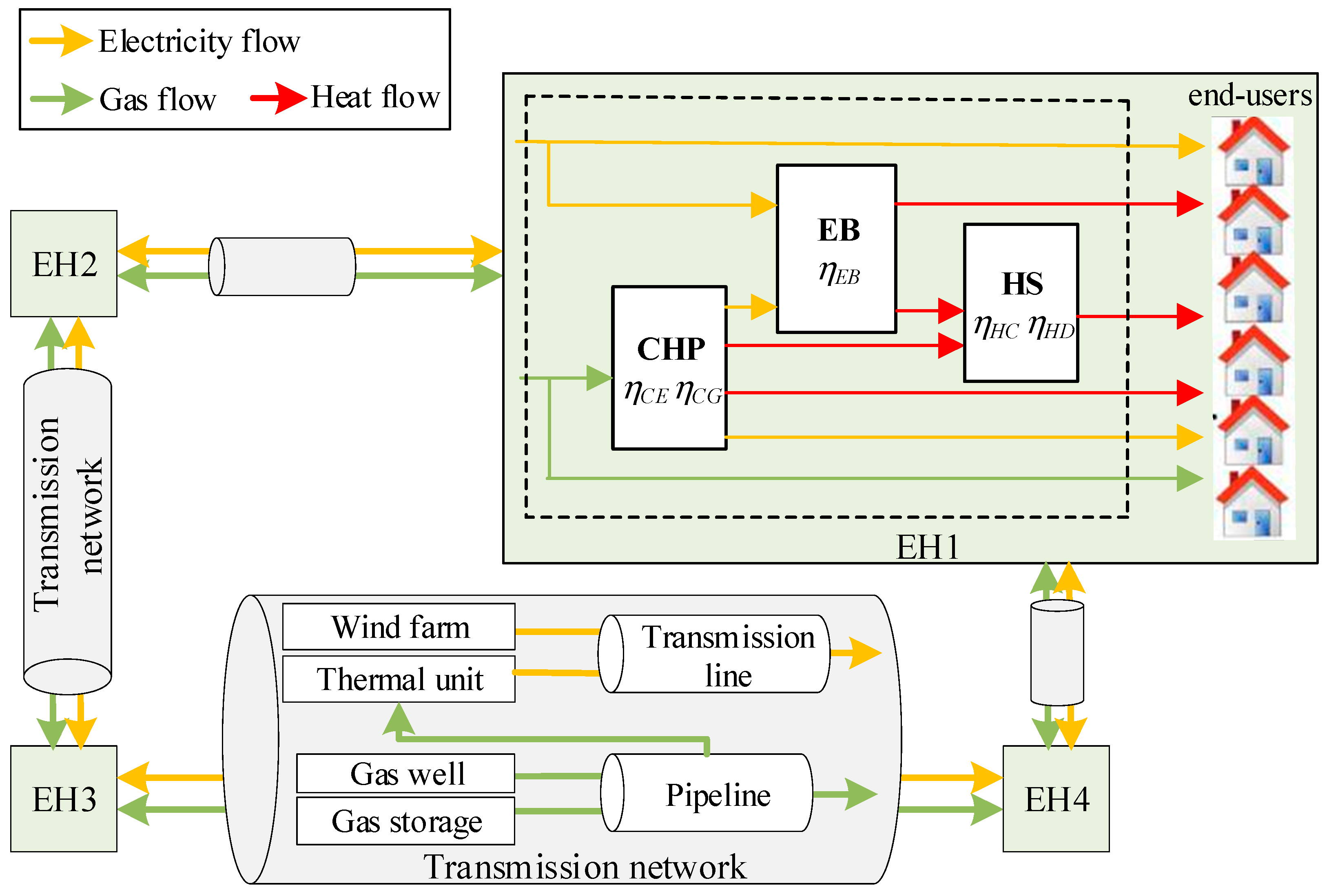
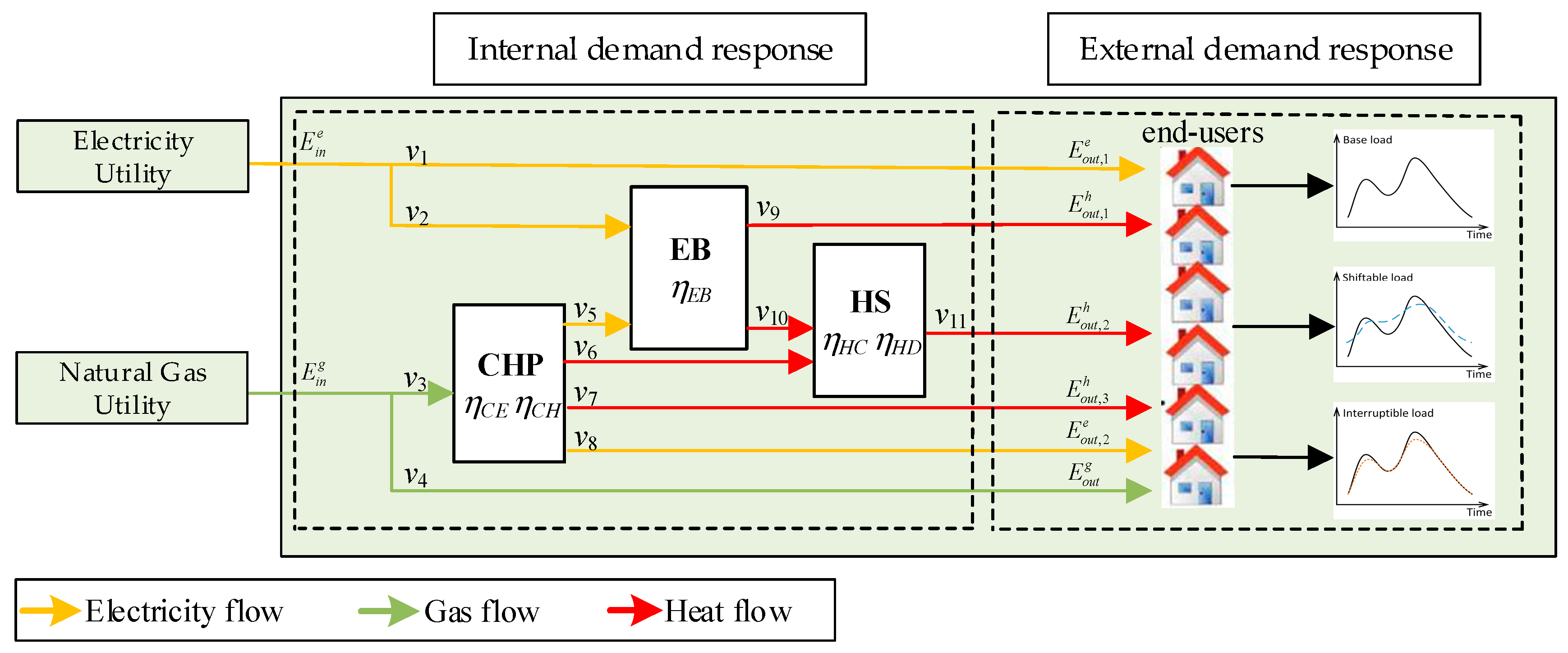
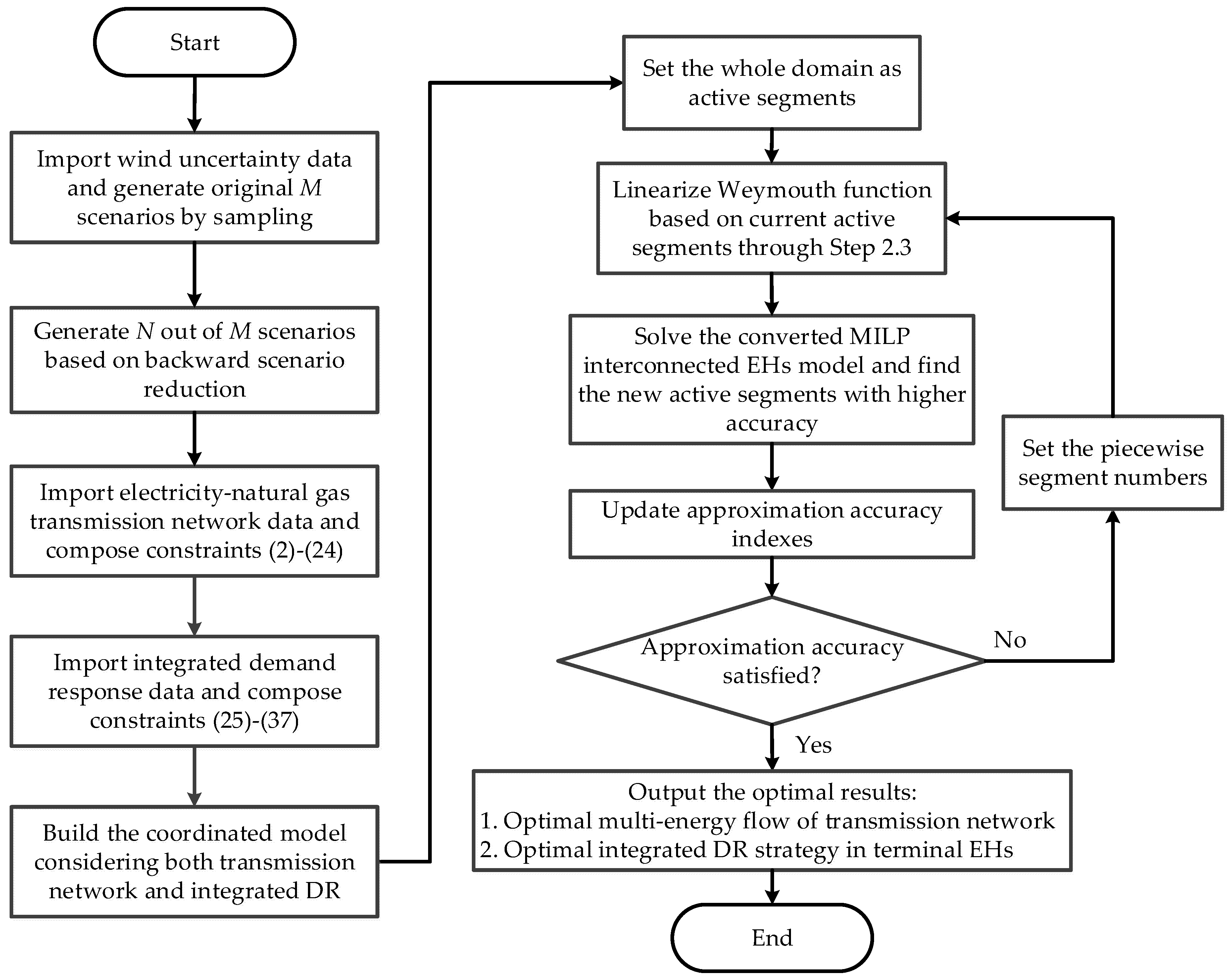
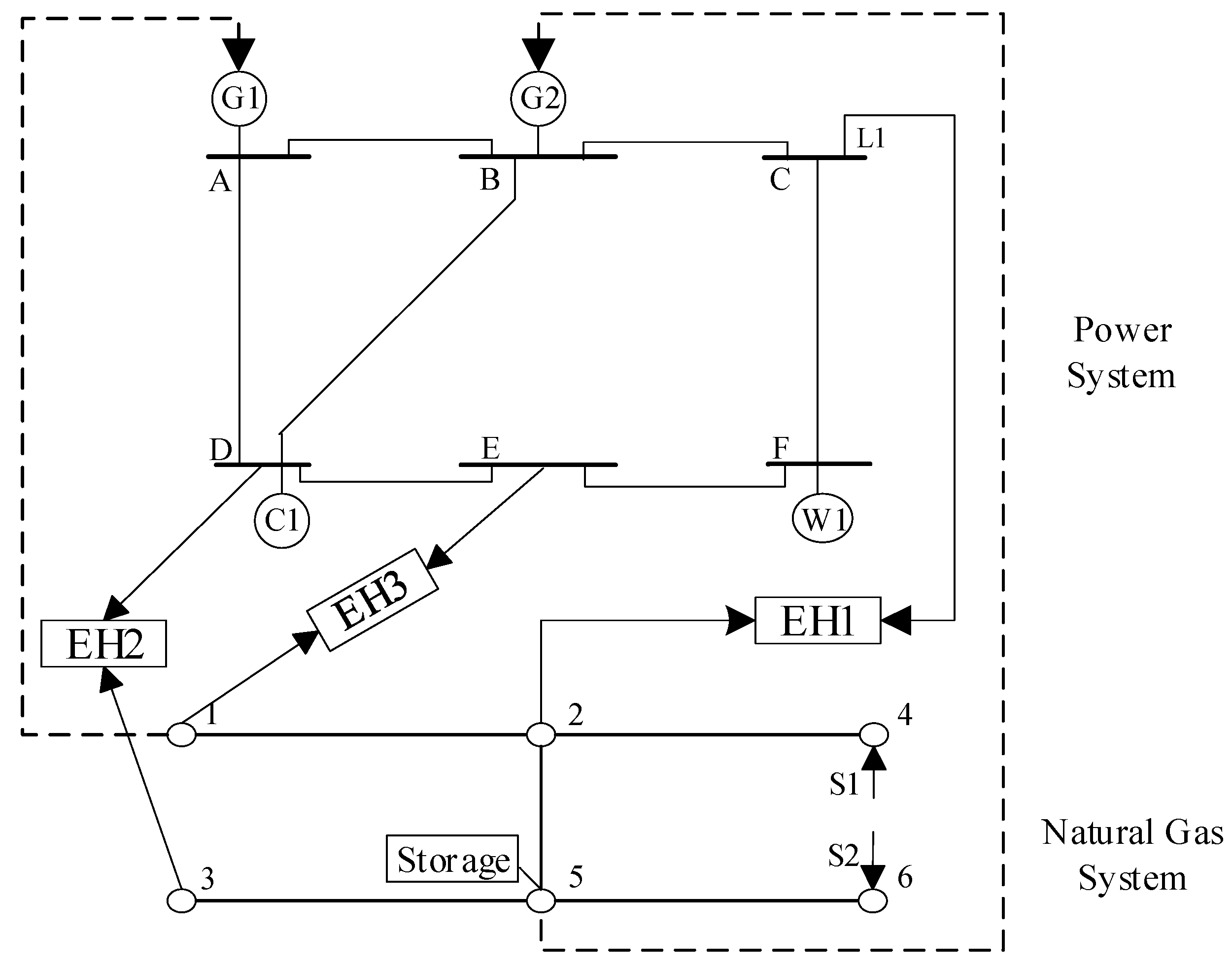
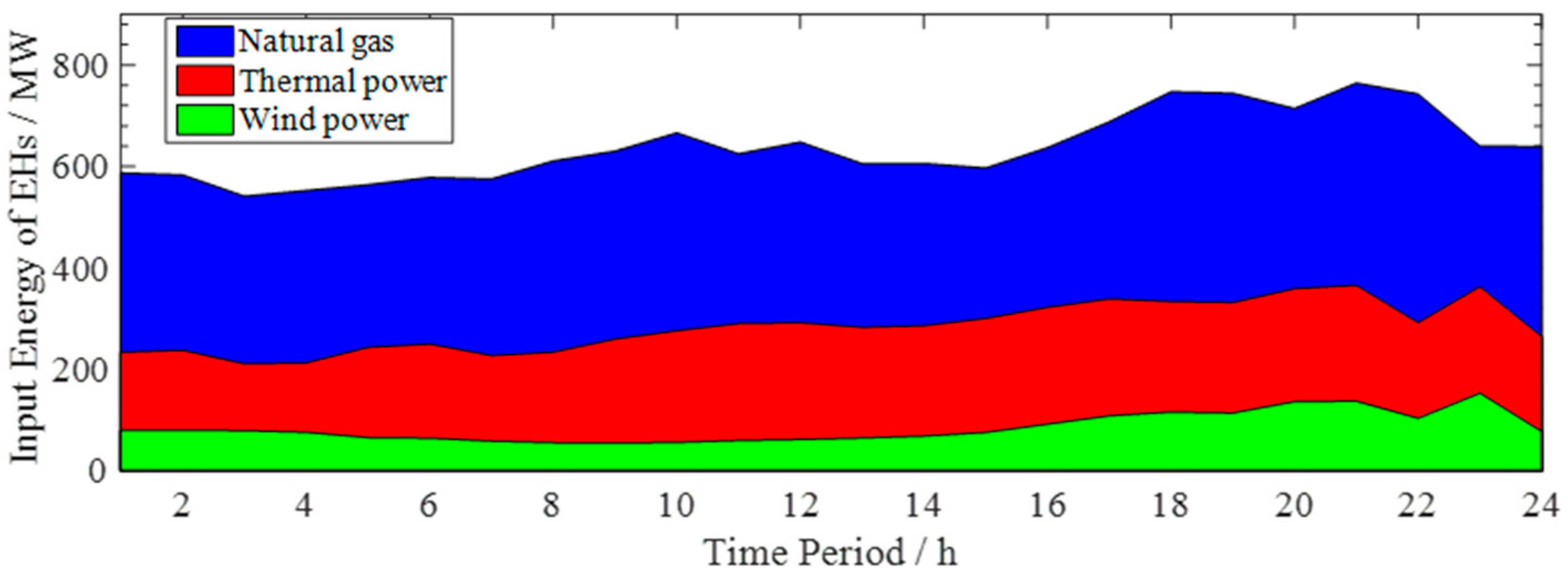
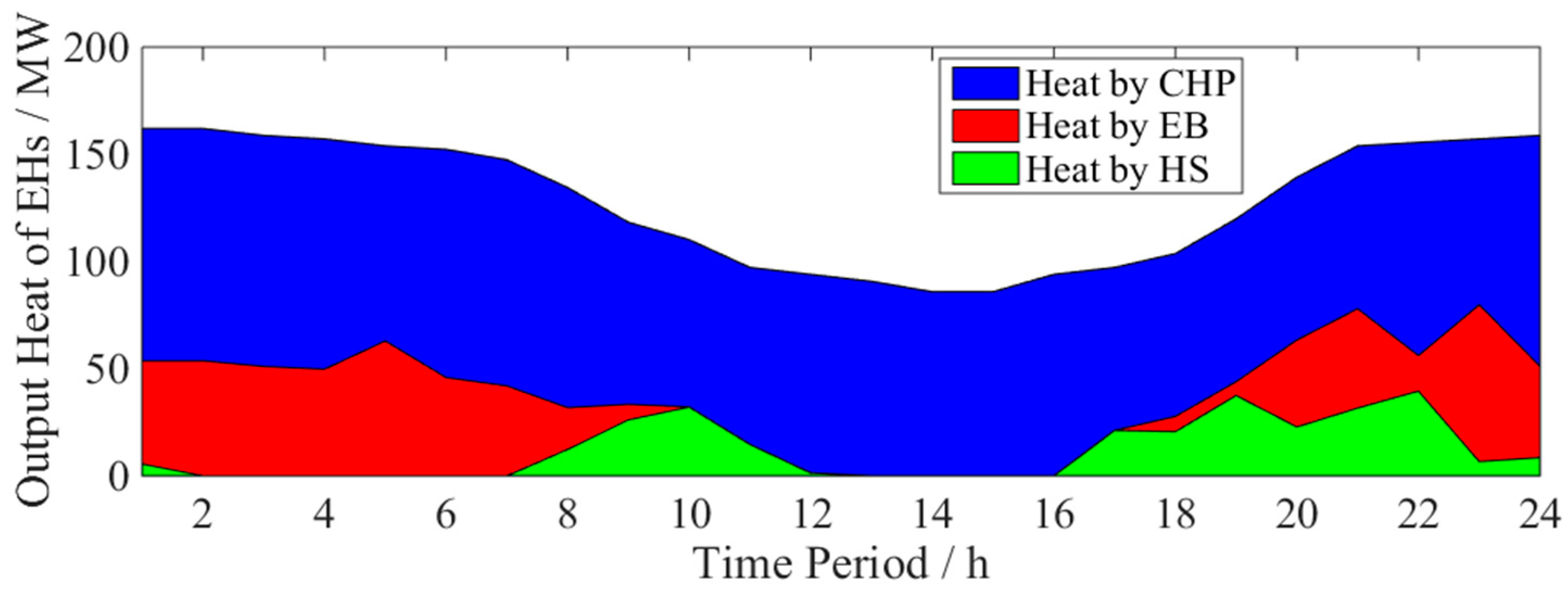
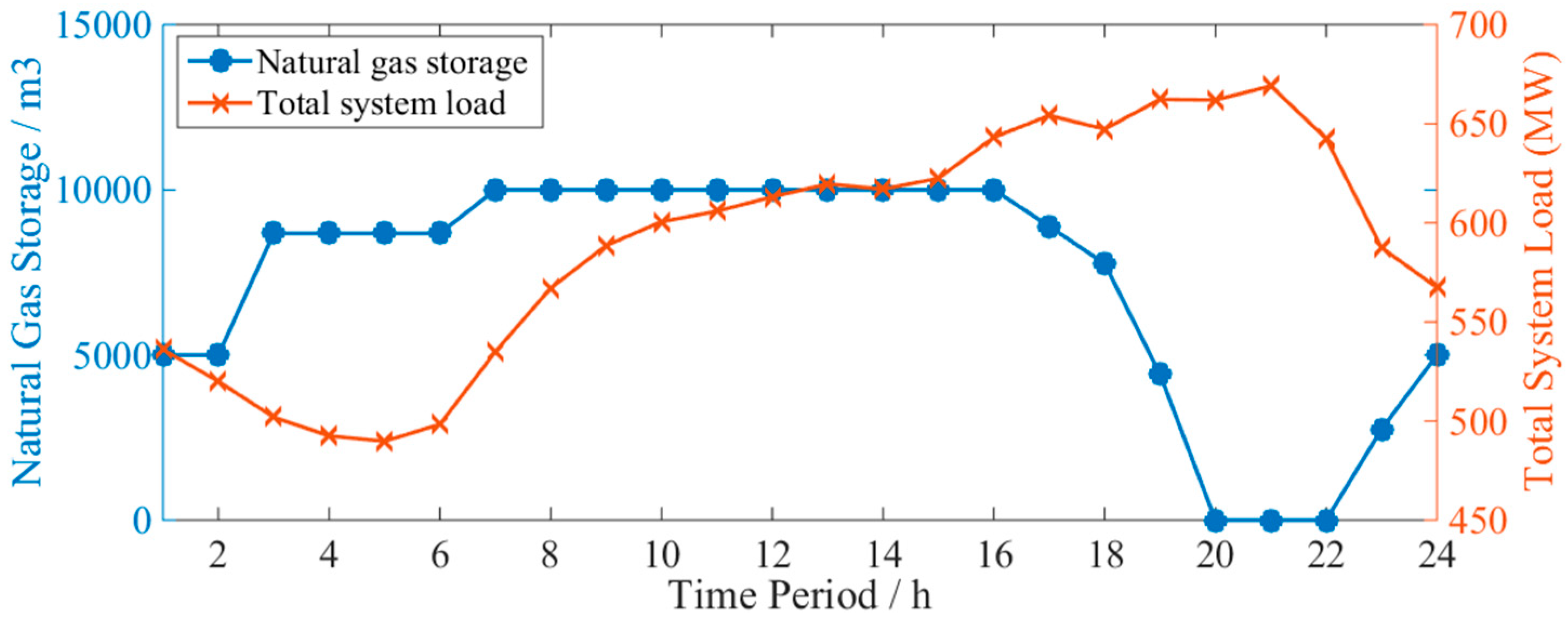
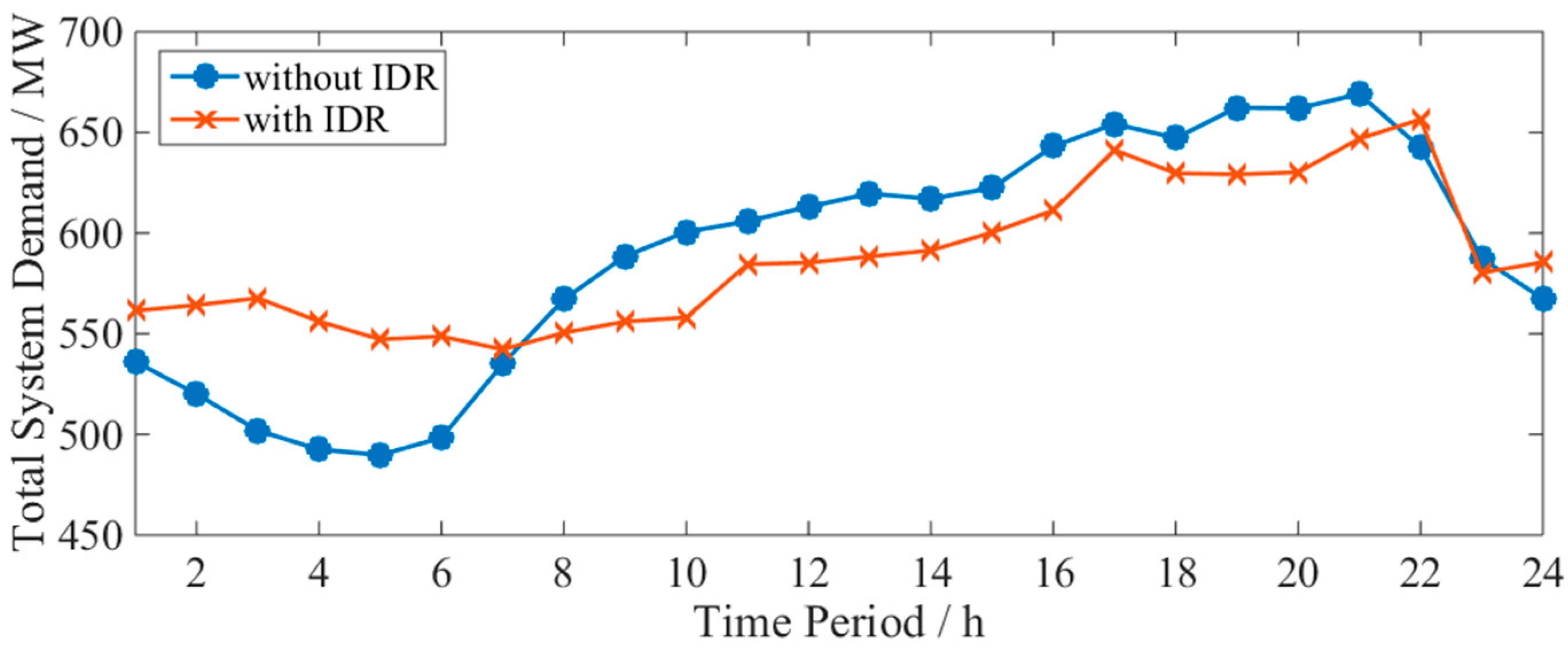
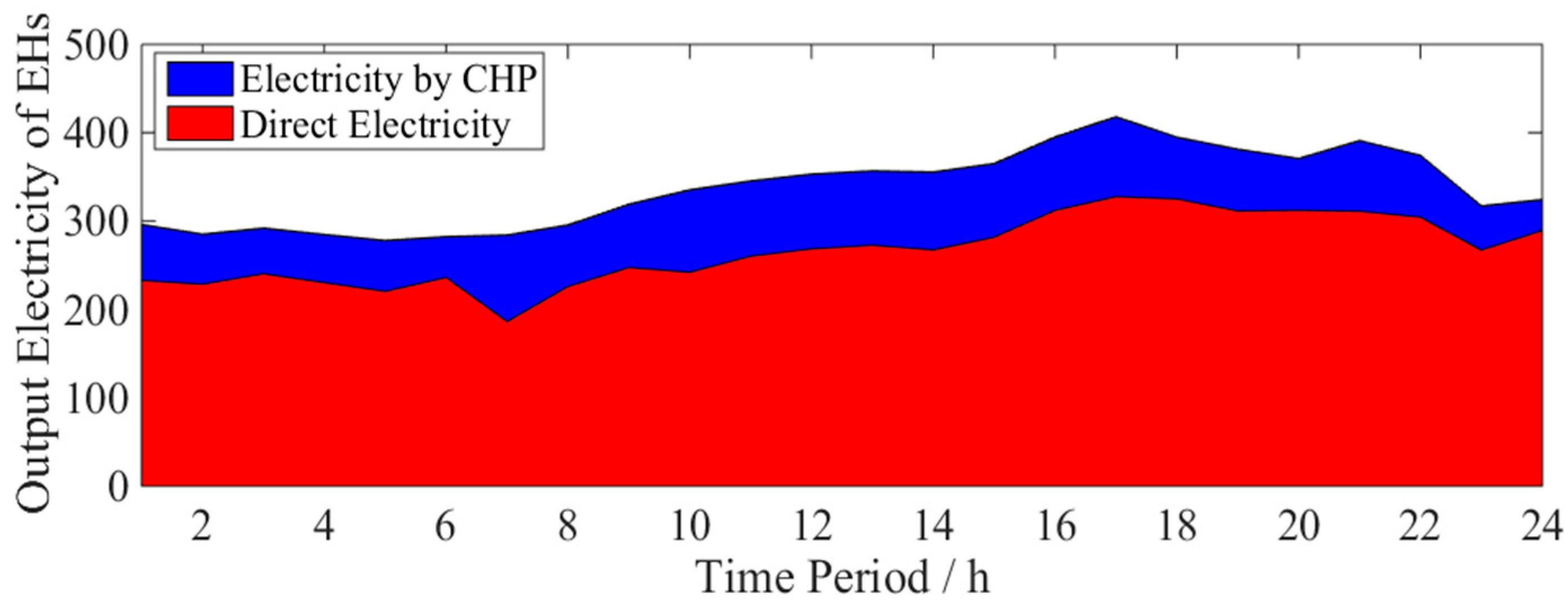
| DR strategy | Total Cost ($) | Coal Cost ($) | Natural Gas Cost ($) | Curtailed Wind (MW) | Interrupted Load (MW) | Shed Load (MW) |
|---|---|---|---|---|---|---|
| Case I | 918,980 | 49,338 | 432,000 | 725.81 | 0 | 423.12 |
| (Without DR) | ||||||
| Case II.a | 816,240 | 49,338 | 422,020 | 435.26 | 0 | 336.12 |
| (Internal DR only) | ||||||
| Case II.b | 670,530 | 49,338 | 422,470 | 223.66 | 457.94 | 148.40 |
| (External DR only) | ||||||
| Case II.c | 503,440 | 49,338 | 423,870 | 116.58 | 278.51 | 0 |
| (Integrated DR) |
| Expected Cost of the Ten Scenarios: $503,620 | |||||||
|---|---|---|---|---|---|---|---|
| Scenario | Probability | Wind Power (MW) | Total Cost ($) | Gas Cost ($) | Curtailed Wind (MW) | Interrupted Load (MW) | Shed Load (MW) |
| S1 | 0.169 | 2387.4 | 501,760 | 423,030 | 75.92 | 278.15 | 0 |
| S2 | 0.030 | 2289.1 | 515,440 | 424,930 | 62.76 | 295.46 | 10.32 |
| S3 | 0.189 | 2482.1 | 501,430 | 421,920 | 143.18 | 272.52 | 0 |
| S4 | 0.074 | 2425.6 | 503,320 | 423,780 | 132.46 | 275.02 | 0 |
| S5 | 0.062 | 2406.9 | 504,640 | 425,050 | 145.75 | 272.84 | 0 |
| S6 | 0.159 | 2367.4 | 505,470 | 425,360 | 114.33 | 284.35 | 0 |
| S7 | 0.053 | 2410.0 | 503,370 | 423,910 | 120.34 | 276.67 | 0 |
| S8 | 0.149 | 2454.8 | 502,170 | 423,260 | 148.82 | 265.42 | 0 |
| S9 | 0.032 | 2307.0 | 511,040 | 424,210 | 57.53 | 295.46 | 6.74 |
| S10 | 0.083 | 2397.8 | 503,970 | 424,060 | 111.93 | 282.76 | 0 |
| Expected Cost of the Five Scenarios: $776,290 | |||||||
|---|---|---|---|---|---|---|---|
| Scenario | Probability | Wind Power (MW) | Total Cost ($) | Coal Cost ($) | Gas Cost ($) | Shed Load (MW) | Curtailed Wind (MW) |
| S1 | 0.252 | 1670.5 | 775,130 | 196,190 | 569,720 | 9.22 | 0 |
| S2 | 0.338 | 1658.1 | 776,070 | 197,130 | 569,720 | 9.22 | 0 |
| S3 | 0.104 | 1603.0 | 779,440 | 198,080 | 569,720 | 11.64 | 0 |
| S4 | 0.140 | 1652.5 | 776,030 | 197,090 | 569,720 | 9.22 | 0 |
| S5 | 0.166 | 1628.0 | 776,750 | 197,810 | 569,720 | 9.22 | 0 |
| Wind Penetration | Total Cost ($) | Wind Curtailment (MW) | Shed Load (MW) |
|---|---|---|---|
| Low Level | 869,060 | 0 | 55.32 |
| Base Level | 776,290 | 0 | 9.44 |
| High Level | 683,630 | 253.2 | 9.41 |
| Results of the Traditional Method (16) | ||||
| Iteration | Total Cost ($) | Flow Segments (Integers) | Pressure Segments (Integers) | CPU Time (s) |
| 1 | 776,290 | 16 * NGL * NT | 16 * NGB * NT | 23574.7 |
| Results of the proposed method in strategy 1 (4 * 4 = 16) | ||||
| Iteration | Total Cost ($) | Flow Segments (Integers) | Pressure Segments (Integers) | CPU Time (s) |
| 1 | 776,240 | 4 * NGL * NT | 4 * NGB * NT | 941.9 |
| 2 | 776,290 | 4 * NGL * NT | 4 * NGB * NT | 876.2 |
| Results of the proposed Method in strategy 2 (2 * 8 = 16) | ||||
| Iteration | Total Cost ($) | Flow Segments (Integers) | Pressure Segments (Integers) | CPU Time (s) |
| 1 | 776,170 | 2 * NGL * NT | 2 * NGB * NT | 210.5 |
| 2 | 776,200 | 8 * NGL * NT | 8 * NGB * NT | 6510.4 |
| Results of The Proposed Method in Strategy 3 (8 * 2 = 16) | ||||
| Iteration | Total cost ($) | Flow segments (Integers) | Pressure segments (Integers) | CPU time (s) |
| 1 | 776,280 | 8 * NGL * NT | 8 * NGB * NT | 8475.1 |
| 2 | 776,290 | 2 * NGL * NT | 2 * NGB * NT | 144.9 |
| Results of the Traditional Nonlinear Model | ||||
| Iteration | Total Cost ($) | Flow Segments (Integers) | Pressure Segments (Integers) | CPU Time (s) |
| 1 | 785,360 (sub-optimum) | - | - | >10 h (not converged) |
© 2018 by the authors. Licensee MDPI, Basel, Switzerland. This article is an open access article distributed under the terms and conditions of the Creative Commons Attribution (CC BY) license (http://creativecommons.org/licenses/by/4.0/).
Share and Cite
Zhang, Y.; He, Y.; Yan, M.; Guo, C.; Ding, Y. Linearized Stochastic Scheduling of Interconnected Energy Hubs Considering Integrated Demand Response and Wind Uncertainty. Energies 2018, 11, 2448. https://doi.org/10.3390/en11092448
Zhang Y, He Y, Yan M, Guo C, Ding Y. Linearized Stochastic Scheduling of Interconnected Energy Hubs Considering Integrated Demand Response and Wind Uncertainty. Energies. 2018; 11(9):2448. https://doi.org/10.3390/en11092448
Chicago/Turabian StyleZhang, Yining, Yubin He, Mingyu Yan, Chuangxin Guo, and Yi Ding. 2018. "Linearized Stochastic Scheduling of Interconnected Energy Hubs Considering Integrated Demand Response and Wind Uncertainty" Energies 11, no. 9: 2448. https://doi.org/10.3390/en11092448




